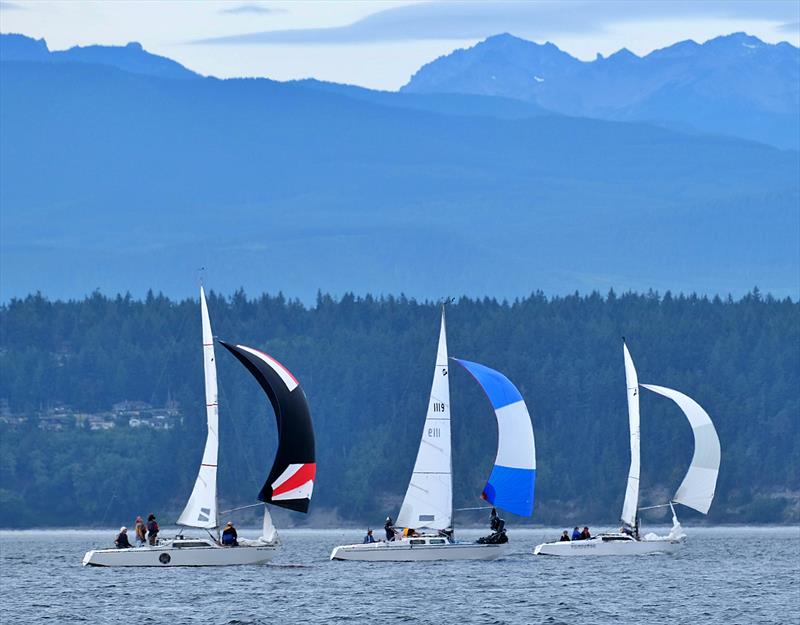
An interview with Dale Dunning on the 2025 Thunderbird PNW Championship Regatta
by David Schmidt 21 Aug 01:00 AEST
August 29-31, 2025

Racecourse action at the 2024 Thunderbird PNW Championship Regatta © the Thunderbird Class Association
One of the coolest aspects about the sport of sailing is the way that certain One Design classes take root in different geographic areas and offer great regional racing. The reasons for this can vary, but sometimes this is because a boat was designed in a locally; other times it's because a class achieves a certain regional critical mass, and other times still it's because a boat is widely beloved.
The Thunderbird, a hard-chined fractional sloop that carries 25.98 feet of waterline, 309 square feet of sail area, and 1,530 pounds of ballast, ticks all of these boxes.
While there are plenty of different boats that are actively raced on Pacific Northwest waters, few designs are as regionally classic—or as regionally respected—as the "T-Bird".
This year's Thunderbird regional Pacific Northwest Championship Regatta is set to unfurl on the waters off of Port Townsend, Washington from August 29 to 31.
I checked in with Dale Dunning, president of the Thunderbird Class Association, to learn more.
Can you please tell us a little bit about the history of the Thunderbird?
That's sort of a long story but for the short version, back in the late 50's the Douglas Fir Plywood Association, in order to promote it's marine plywood product, decided to have a contest to develop a sailboat that was fast, cruiseable, and to be capable of being built by average skilled amateurs with typical wood working tools.
Ben Seaborn, the boat designer, and Ed Hoppen, a boat builder in Gig Harbor worked closely to come up with the design we now call the Thunderbird.
Could you please explain the regional significance of the boat for readers who might not be familiar with the design?
The Thunderbird's origins began in the Puget Sound area and although later on boats were professionally built in Japan, Australia, Vancouver BC, and Ontario Canada, the Thunderbird's heritage and soul is tied to this region.
Fleet number 1 was started in Tacoma and Fleet number 2 in Seattle.
Is it true that most Thuderbirds are home-builds? Or are there local builders that produce (or used to produce) the boats commercially (or maybe as one-offs)?
Yes, most of the original Thunderbirds were home-built. Before the advent of fiberglass, there were two professional builders that I know of. Between them I'm sure less than 50 boats were built.
Beginning with hull number 1001, a number of professional builders began producing fiberglass Thunderbirds. There were just over 200 fiberglass boats built so that leaves somewhere in the neighborhood of 800 to 900 home-built boats.
How many boats are you expecting at this summer's Thunderbird PNW Championship? Also, are most of these boats from Puget Sound or the greater Salish Sea area?
I would expect between 10 to 14 boats this year. All of them I know of will be from the greater Salish Sea.
What kinds of sailors can one expect to meet on the docks of the Thunderbird PNW Championship? What about in the Thunderbird class in general?
For this regatta, you will meet some of the very best sailors in the entire region. There are a lot of friendships that go way back because we have had such a long history together.
At the dock and off the water we are certainly friends, but on the water there is a fierce competitiveness.
A newcomer shouldn't be worried or intimidated about this but don't expect to be at the front of the fleet. It takes awhile to master the boat.
Weather wise, what kind of conditions can sailors generally expect to encounter on the waters off of Port Townsend in late August?
Summer in Port Townsend is pretty incredible. We generally always have decent wind, even when the forecast doesn't call for it. There is a real local geographical effect here.
Even when there is no wind there are spots such as the bay over by Fort Worden where the wind always seems to blow. We call it the Hurricane!
How much of a factor do you see local knowledge playing at this high-level regatta?
Port Townsend Bay has wild, strong, and wacky currents. Local knowledge is definitely a plus, but we have done this regatta here so often that I think most people have caught on.
If you could offer one piece of advice to visiting (and local) sailors, what would it be?
Have fun and enjoy the moment!
Is there anything else about the Thunderbird PNW Championship that you'd like to add, for the record?
Before I moved to the Olympic Peninsula, I lived in the Seattle area. We have hosted a lot of the regional championships in Port Townsend. This is going all the way back to 1998 for me. I loved bringing my boat up to PT and spending a great three-day weekend.
The racing is intense and very competitive with a gorgeous backdrop of Mt. Baker, the Cascades, the Olympic Mountains, and the comings and goings of the ferries and other marine traffic. There is nothing like it and if you aren't here sailing, I feel sorry for you.